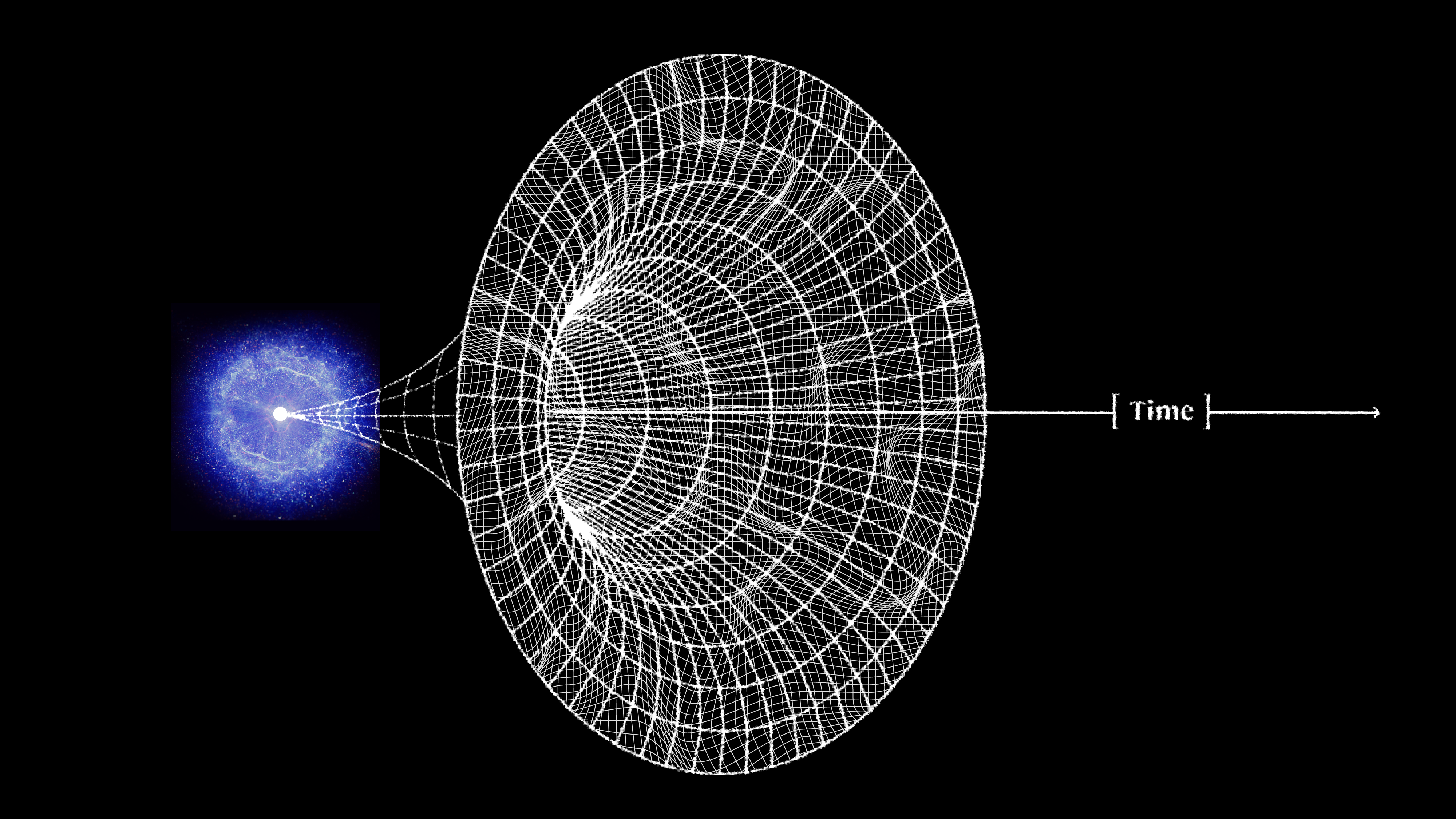Ask Ethan: How do we know the timeline of our Universe?
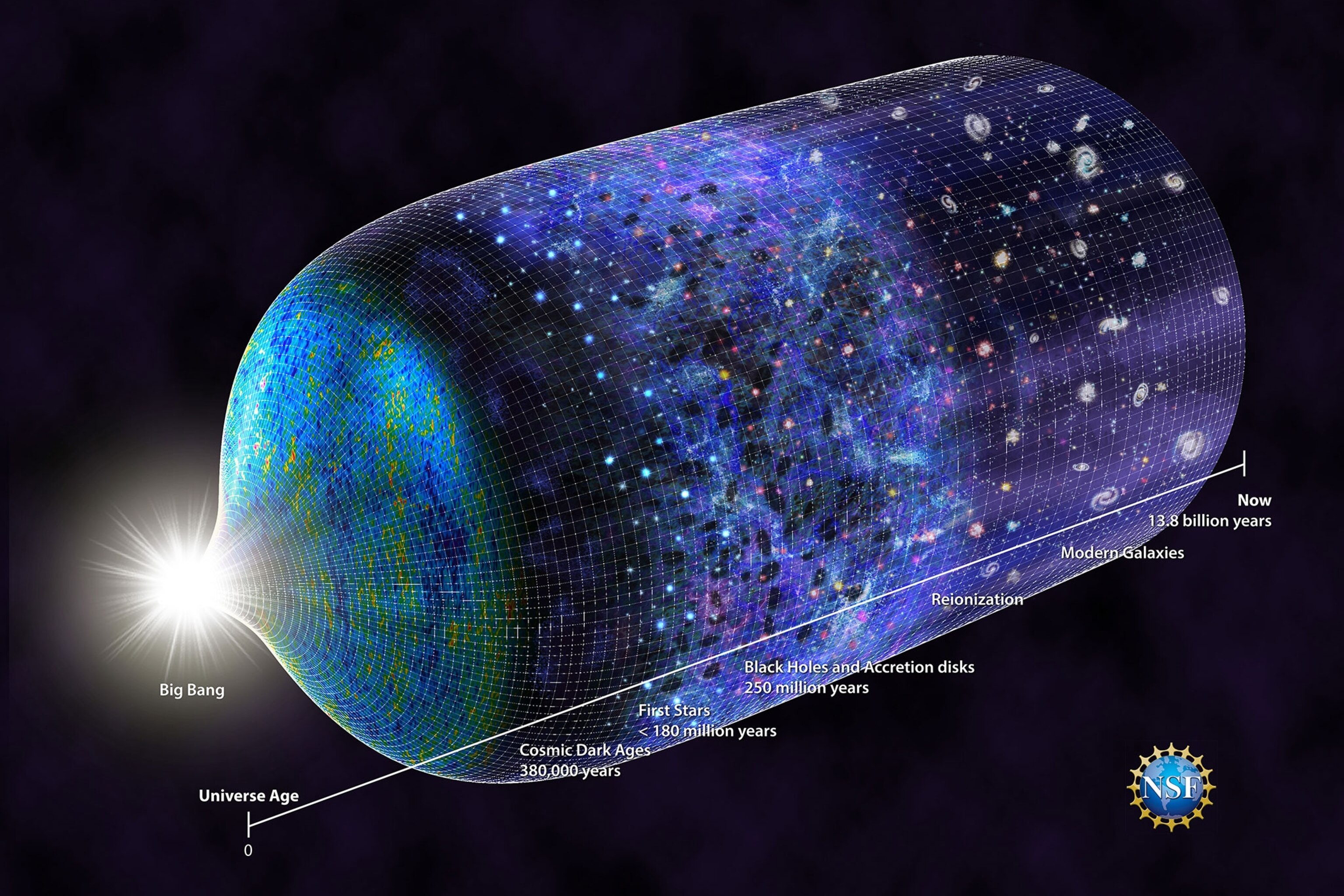
- Our Universe arose in the aftermath of cosmic inflation, triggering the hot Big Bang some 13.8 billion years ago that eventually gave rise to us.
- The Universe passed through many epochs, from free quarks and gluons to stable protons and neutrons to neutral atoms to stars, galaxies, planets, and more.
- And yet, we can pinpoint the precise time at which these various epochs occurred, including the (current) dark energy-dominated era. Here’s how we know.
Today, it’s now 13.8 billion years since the Big Bang occurred. Our observable Universe extends for 46.1 billion light-years in all directions, and is made of:
- 68% dark energy,
- 27% dark matter,
- 4.9% normal (atom-based) matter,
- 0.09% neutrinos,
- and 0.01% radiation,
with no hint of other components like spatial curvature, cosmic strings, domain walls, or any other weird stuff we can imagine.
If we were to run the clock backward, however, we’d find that dark energy wasn’t always dominant. There was a time when matter dominated, and before that, when radiation did. There was a time when there were no stars, no neutral atoms, no atomic nuclei, no protons and neutrons, and even no massive particles.
But how do we know precisely when these events and epochs occurred? That’s what Marshall Randolph wants to know, asking:
“When I read about the epochs of the universe, they are tagged with a specific time. The Hadron epoch, for example, started at 10^-6 seconds. The timelines of the epochs are given almost as if I should know them. Are they easily calculated by physicists? Could you describe the methods in a way I can understand?”
I very much think so. Let’s recount the cosmic story of how we came to be and how we know precisely when those events happened.

In the beginning — at least, as far back as we can trace things — the Universe was inflating. That means it was expanding relentlessly, doubling in scale in all directions with each tiny fraction-of-a-second (something like 10-35 seconds) that goes by. After only a few hundred of those doublings, a tiny quantum fluctuation occurring on Planck scales, the smallest scale we can describe before the known laws of physics break down, gets stretched to scales even larger than the observable Universe. Because of this rapid expansion, the Universe quickly empties; the only thing in it is empty space, and the large amount of energy tied up in whatever quantum field caused inflation, plus the small amount of “fluctuation energy” arising from the stretched quantum fluctuations occurring on all scales.
Then inflation ends, and that field energy gets converted into all the quanta we know of. Particles and antiparticles of all types, including photons, get spontaneously created at very high energies and very large densities. They’re almost uniformly distributed, with an average “overdense” region and an average “underdense” region departing from the average density by just one part in ~30,000 or so. From this point on, the Universe always expands, cools, and gravitates, and all sorts of events in the evolutionary history of our Universe occur.

At the start, these quanta all collide with one another at tremendous rates: quadrillions of times per second. They’re all massless, so they’re all moving at the speed of light, possessing very large amounts of energy. But as the Universe expands, it also cools: remember that all particles, massive or massless, can be described by a wave as well, and the wavelength of any wave determines its energy. As the Universe expands, the wavelength of all waves get stretched, meaning they lose energy and the temperature of the Universe drops.
At some point:
- the Universe cools enough so that the shortest-lived, most unstable particles and antiparticles begin decaying,
- the Higgs and electroweak symmetries break, giving rise to rest mass and separating the weak and electromagnetic forces,
- the quarks-and-antiquarks and gluons, previously free particles, become grouped into protons, neutrons, and other bound states known as hadrons,
- the antimatter annihilates away with most of the matter, creating a great bath of radiation and just a small population of excess matter,
- nuclear fusion can occur without composite nuclei immediately being blasted apart,
- matter overtakes radiation as the dominant component of the Universe,
- neutral atoms can stably form, giving rise to a Universe that’s now transparent to visible light,
- the first stars form, paving the way for the era of stars and galaxies,
- and then dark energy overtakes matter as the dominant component of the Universe, ensuring our cosmic fate to be driven away from all unbound galaxies and groups/clusters of galaxies.
That’s a very rough outline of the history of the Universe.

Now for the big question: how can we determine when all of these things happen?
The way we normally do this is straightforward — at least conceptually — even if the mathematics itself is a little difficult. Where we start is by recognizing the following three things:
- The Universe presently has a “bath” of background radiation that’s left over from the Big Bang, with an average temperature, today, of 2.7255 K.
- The Universe presently has a specific “size” or “scale” to it, which we believe is very close to 46.1 billion light-years in radius, but which we can just call “the size today.”
- And that, because the Universe is continuously expanding and cooling, it was smaller and hotter and denser in the past, and we can determine “How hot was it?” at any point in time simply by recognizing that if you take the temperature today and divide it by the ratio of “the scale of the Universe back then” to “the scale of the Universe today,” you’ll get the temperature of the Universe back at any epoch you desire.
Therefore, if you know either:
- what was the temperature/energy at which this specific event-or-transition occurred,
- or what was the scale, relative to today’s scale, at which this specific event-or-transition occurred,
you can do the math to figure out precisely when, in terms of our cosmic history, these events and eras took place.
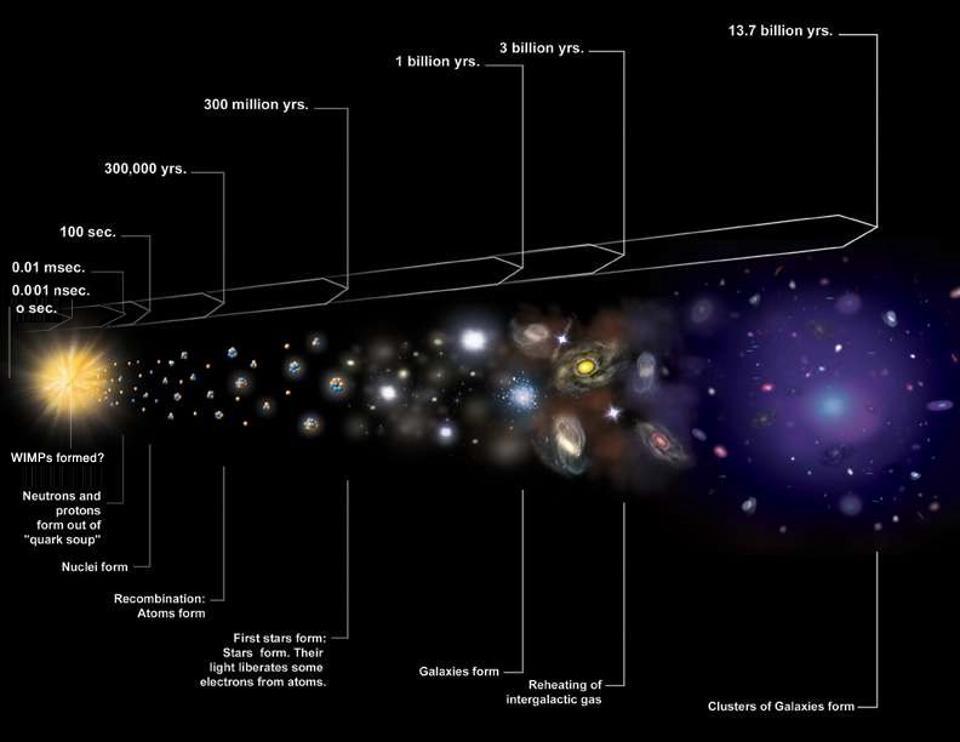
Figuring out either temperature/energy or relative scale at which certain events occurred is relatively straightforward. For events that occur in the context of particle/high-energy physics, we simply need to look to our experimental data to figure out at what energy/temperature they occur at. For events that occur throughout the history of the Universe, these can either be measured or calculated using one of two straightforward methods.
- For events that can be determined observationally, we can measure the redshift at which they occur/exist, by comparing the observed emission/absorption lines generated by atomic or molecular transitions with the same lines generated by that same molecule or atom within the lab. The ratio of observed-to-rest-frame wavelength equals the ratio of “the scale of the Universe back then” to “the scale of the Universe today,” and that ratio, minus the number 1, is the definition of redshift.
- For events that can occurred at some point in the Universe’s past, we can calculate “What was the scale of the Universe back then?” simply by numerically integrating the equation that governs how the Universe expands over time: the first Friedmann equation.

If you can figure out what the Universe’s scale factor was when a specific transition occurred, then you can do a little math to determine “At what time in the Universe’s history was the Universe this specific size/scale?” Again, this requires some numerical integration, but there’s a short-cut you can use that works pretty well for the first few billion years of our cosmic history: assuming the Universe was either made 100% out of radiation (which works for the first ~10,000 years), or assuming that the Universe was made 100% out of matter (which works for the next ~7 billion years).
The short-cut is as follows.
- If your Universe is made 100% of radiation, then it expands according to a simple rule: the scale factor grows with time as a ~ t½.
- If your Universe is made 100% of matter, then it expands according to a simple rule: the scale factor grows with time as a ~ t⅔.
- And if your Universe is made 100% of dark energy, which dominates the expansion at late (modern) times, the scale factor grows exponentially: as a ~ eHt.
If we fill in the in-between stages, or just calculate the whole thing directly without using short-cuts, we can determine the scale/size of the Universe as a function of cosmic time.

That’s it, as long as you realize
- that the ratio of the scale of the Universe at any time to the scale of the Universe today
is equal to
- the temperature of the Universe at any time to the temperature of the Universe today,
you can calculate at what time any event occurs if you know either how big the Universe was at that time relative to today or you know what the temperature of the Universe was at that time relative to today.
With that said, all we need to remember is that the temperature of the Universe, today, is 2.725 K, and that the size/scale/redshift of the Universe today is 46.1 billion light-years/defined as 1/defined as 0, and also that the age of the Universe, today, is 13.8 billion years after the Big Bang. As long as you start with today’s composition of the Universe — 68% dark energy, 31.9% matter, 0.09% neutrinos and 0.01% photons — and you recognize that everything behaves as radiation when it moves at or very close to the speed of light, you can’t go wrong.
With that said, here is a summary of the various eras/epochs, from the earliest moments we can speak of until the present day.

Inflationary era: This is a tricky one, but only in the sense that we don’t know when, how, or even if it had a beginning, but we do know that it lasted at least some ~10-33 seconds, and that when it ended, the hot Big Bang began.
Free, unbound, massless particle-and-antiparticle era: This is what you might think of as the Universe’s “primordial soup,” where every possible collision that you can imagine occurs in great abundance. There are no bound structures; there are no stable configurations; any particle that you can track likely gets annihilated and transforms into other particles many, many times over. This lasts from the end of inflation right up until the Universe is about ~10-10 seconds old, or ~100 picoseconds.
Massive particle-and-antiparticle/quark gluon plasma era: After about the first ~10-10 seconds, the Higgs and electroweak symmetries break, separating the electroweak force into the electromagnetic and weak forces, and giving mass to the Universe. This transition is also the final opportunity for the Universe to create a matter-antimatter asymmetry; if it hasn’t happened before now, this is its last opportunity. As it expands and cools, the heavier quarks-and-antiquarks decay away, as do the tau-antitau lepton pairs. This continues until the Universe is about one microsecond (~10-6 seconds) old, when the next major transition happens.
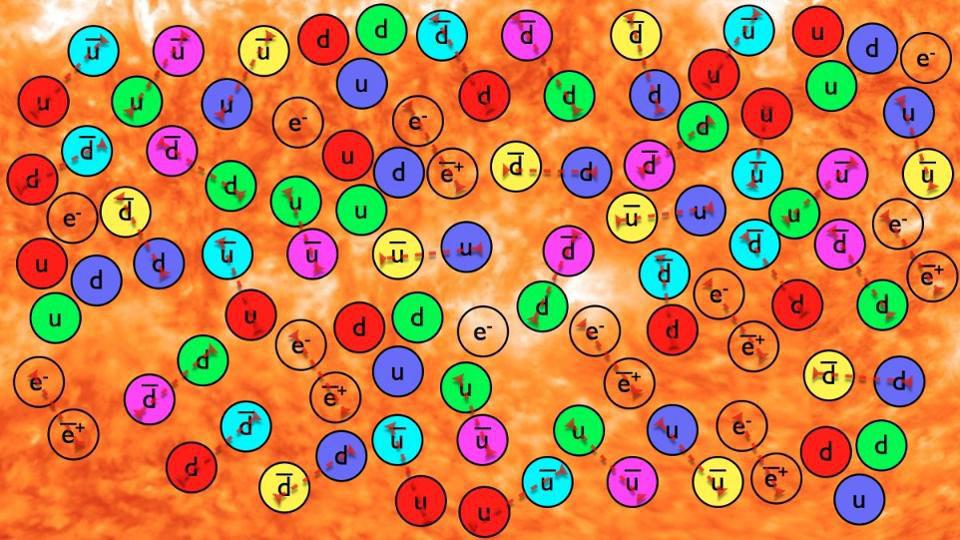
Hadron era: Prior to this point, quarks-and-antiquarks and gluons were still in a primordial soup: the quarks-and-antiquarks had masses, but wouldn’t form bound states, as the energies and densities were too great. But now, groups of three quarks form baryons like protons and neutrons, groups of three antiquarks form anti-baryons, and quark-antiquark pairs form mesons. All of the mesons are unstable, and decay quite quickly, while the remaining anti-baryons all get annihilated away by baryons, producing an enormous bath of radiation. At the end, there are a whopping ~1 billion photons left over for every baryon, but no surviving antibaryons. This lasts until the Universe is about 1 second old, and a handy rule-of-thumb is that an age of ~1 second corresponds to an average energy-per-particle of 1 MeV, or a temperature of ~1010 K: ten billion degrees.
Nuclear era: At an age of ~1 second, neutrinos stop interacting regularly with the remaining particles and antiparticles in the Universe, and almost immediately after, the remaining positrons annihilate with a huge excess of electrons, producing even greater numbers of photons, and heating them so they’re slightly hotter (by about 40%) than the neutrinos. Nuclear fusion is attempting to occur between protons and neutrons, but the photons blast them apart until the Universe reaches about ~3 minutes of age. At last, now that it’s cool enough, nuclear fusion occurs, forming deuterium, tritium, helium-3, helium-4, and both lithium-7 and beryllium-7. By the time the Universe is about 4-to-20 minutes old, all of this is done.
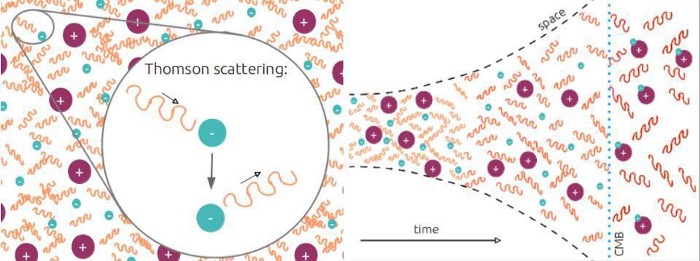
Plasma era: It’s now too cold and too sparse for fusion reactions to occur, and all of the tritium decays to helium-3 while all of the beryllium-7 decays to lithium-7. Protons and the other atomic nuclei would love to bind together to electrons, but they can’t without getting immediately blasted apart by a high-energy photon. At an age of about ~9,000 years, radiation quits being the dominant component of the Universe, replaced by the combination of normal-and-dark matter. This lasts until the Universe reaches an age of about 380,000 years, and a temperature of merely ~3000 K.
Atomic era: At last, at this point, 380,000 years after the Big Bang, the Universe forms neutral atoms, and is now transparent to light, including the radiation left over from the Big Bang. But because the densest overdense regions and the least-dense underdense regions are still so close to the cosmic average, it takes time for gravitation to collapse these atoms down to where they can form stars. Although the exact number isn’t yet known, we can ballpark it to last until the first stars form, say, 100 million years after the Big Bang.
Stellar-and-galactic era: Beginning roughly 100 million years after the Big Bang, now “Let there be light” has officially occurred for the second time: with the birth of stars and star clusters. These will grow and merge into galaxies, galaxy groups, and clusters, and will align along great cosmic walls, eventually forming the modern cosmic web.

Although this process persists far into the future, we’ve already entered the final one: the one that describes our Universe now and will describe our Universe for all-time afterward.
The dark energy era: There are two ways to define its onset, depending on whether you define “dark energy dominates the Universe” as talking about
- when the recession speed of a distant galaxy stops slowing down and starts speeding up,
- or when dark energy becomes the dominant form of energy in the Universe, overtaking matter.
By the first definition, dark energy dominates the expansion rate of the Universe at an age of 7.8 billion years after the Big Bang. By the second definition, that domination is delayed until the Universe is 10.4 billion years after the Big Bang. Right at the same time that the first photosynthetic organisms evolve on Earth, dark energy passes both dark matter and normal matter combined to dominate the energy content of the Universe.
And that’s the way it will be, forever and ever into the future, at least to the best of our knowledge. This timeline can be made more-or-less granular, but that’s how we know it and how we figure it out!
Send in your Ask Ethan questions to startswithabang at gmail dot com!




